NorthEast Radio Watch 12/8/2025: Cichon’s Back in Buffalo
In this week’s issue… Veteran newsman returns - Remembering NY's Leitner, RI's Jones - CT AM saved - Maine AM moves - "Indie" adds suburban signals
Text and photos by SCOTT FYBUSH
Before we could even think about leaving Omaha at the end of our February visit, there was one site we knew we couldn’t possibly miss. After 50 years of broadcasting from the middle of the University of Nebraska-Omaha campus on Dodge Street, the tower that carried public broadcaster KYNE (Channel 26) was removed this spring, and so we were eager to pay one last visit to the site before it made way for more construction on this busy campus.
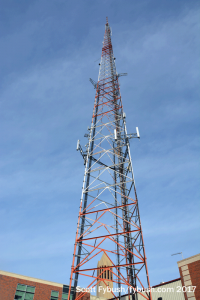
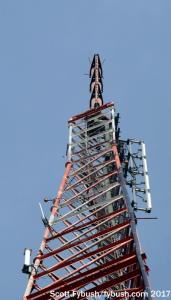
The 350-foot self-supporting tower was a tiny blip on the Omaha skyline compared to the big TV towers in the Crown Point farm to the northwest that we showed you last week, but it holds an important place in our heart – it was from this tower that a young Mrs. F. first saw “The Electric Company” and other PBS programs in the early 1970s when visiting her grandmother in Omaha, back when her hometown didn’t yet have a public TV station.
Nebraska Educational Television (NET) kept using this tower when it went digital on RF 17 in 2003, but the tower was silent by the time we got there, with KYNE having moved up to Crown Point and the KETV tower, leaving its old top-mounted analog and side-mounted digital antennas behind (as well as the STL for UNO-based public radio station KVNO 90.7, which engineer Dave Kline was scrambling to replace!)
We didn’t get in to the empty old KYNE transmitter room, but the warren of hallways that leads back from the doors near the tower base take us through UNO’s in-house TV operation, UNO TV. Its studios date back to the days when the state of the art dictated that a control room should have big windows looking right down on the studio floor – and the back rooms include a museum of vintage technology such as that 2″ quad VTR shown above at right.
Over on the Dodge Street side of the building, a neat line of studios provides a functional home for KVNO’s public radio programming, including a newsroom and two control rooms flanking a talk studio.
While KVNO is a professionally-run operation (just like its public radio counterpart in town, the Omaha schools’ KIOS 91.5), the UNO students have a nice streaming outlet in the form of “Mav Radio,” with studios just down the hall from KVNO.
(As for KYNE, its programming these days is entirely fed by NET’s main studio in Lincoln, which we’ll show you in next week’s installment.)
With about two hours left before our flight was set to take off from Omaha’s Eppley Airfield, we still had one more important stop to make, at one of the neatest TV studio facilities we have ever seen anywhere.
On an earlier visit to Omaha, we’d toured the longtime home of ABC affiliate KETV (Channel 7) at 27th and Douglas just west of downtown Omaha. That building (and the tower next to it) went up in 1957 when KETV went on the air, but as development grew in the area, KETV owner Hearst went looking for a new home and ended up renovating a long-vacant city landmark.
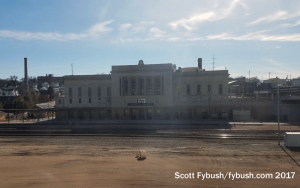
The Burlington train station on the east edge of downtown Omaha was one of two majestic railroad facilities that faced each other across a sea of tracks near the Missouri River. On the north side of the tracks, the majestic Union Station was reborn in the 1970s as the Durham History Museum, but on the south side of the tracks, the Burlington station closed in 1974 and fell into a long decay.
(The view at right is from the galleries at the Durham that look out across where the tracks used to be.)
Hearst bought the building in 2013 and embarked on two years of renovation, putting a state-of-the-art digital TV plant inside this 1898-vintage building while retaining plenty of its historic character.
The building’s main entrance on the south side opens into the former waiting room, a big hall located one floor above track level. At one end of the main floor, KETV built a public meeting room and lined the walls with images of KETV’s history and the building’s history, too, complete with vintage waiting-room benches and a separate entrance facing 10th Street.
The architects opened up a big circle in the waiting room floor, providing a dramatic view all the way from the newsroom down below at track level up to the high ceiling of the waiting room. (The roof isn’t original; it’s a modern replacement after the original station’s roof was destroyed during its long vacant period.)
The design of what’s now known as “7 Burlington Station” even incorporated some recognition of that vacant period – the station’s break room, across the waiting room atrium from the main entrance, preserves some of the graffiti art that filled the building in the 1990s and 2000s. This being Omaha, the bottom part of the art was tiled over so as to cover up the, er, naughty bits…

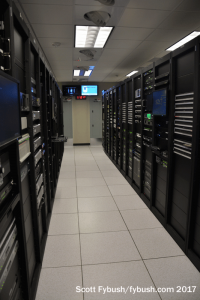
Descending to track level, we enter one of the niftiest newsroom areas we’ve ever seen.
The assignment desk sits right below the oculus opening, surrounded by pods of desks for reporters and producers, all surrounded by the white tile and vaulted ceilings that once greeted travelers heading out the doors from this level to waiting cabs and trolleys outside.
Nowadays, those doors are used by reporters and photographers heading out to waiting news cars parked at track level, below the main KETV parking lot and entrance; when they exit, it’s under some of the original ornamentation from the station. Where the doors on the north side used to lead out to the tracks, there’s now a glassed-in conference room adjoining the main newsroom.
Technical areas stretch east and west along hallways from the rotunda/newsroom; to the east is master control (complete with some of the white tile detailing!), rack room and engineering offices, while the hallway to the west runs past the production control room to the compact but functional studio.
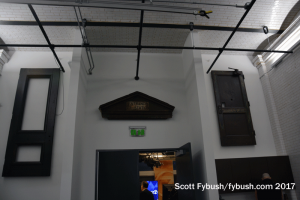
It’s no coincidence that the set design is distinctly circular; it was meant to mirror the oculus opening above the assignment desk.
And what other TV studio anywhere has pieces of interior ornamentation from an 1898-vintage train station decorating the walls around the studio doors? We sure can’t think of any.
(In fact, we’re inclined to think this may be the oldest building anywhere that houses a current TV studio – does anyone have any other nominees?)
From downtown Omaha, it’s a short drive up along the river (through a tiny little bit of Iowa that got cut off from the rest of the state when the river’s path shifted) to get to Eppley Airfield, where we made our flight with a few minutes to spare.
But we’re not quite done with Nebraska – join us again in this space next week for a few tours from the state capital!
Thanks to Dave Kline at UNO and Ariel Roblin and Warren Behrens at KETV for the tours!
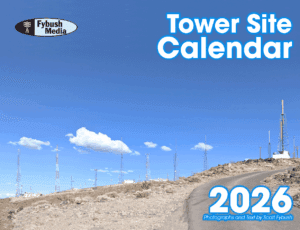
As we announced a few weeks ago, the 2026 edition of the Tower Site Calendar will be the last.
We began publishing it 25 years ago, and the broadcast landscape is radically different now.
Radio World just ran an excellent article about us if you want to know more.
Once it’s gone, that’s it. We won’t be printing any more.
Thank you to everyone who saw our announcement and rushed to buy it. We appreciate you.
(There are some calendars from previous years if you want more of a tower photo fix — all under $5.)
But don’t wait to get this year’s Tower Site Calendar — buy it now!
We are selling the Broadcast Historian’s Calendar again this year, but we have that in an even smaller quantity — definitely don’t hesitate for that.
And visit the Fybush Media Store to check out our selection of books and videos, too!
And don’t miss a big batch of Omaha IDs next Wednesday, over at our sister site, TopHour.com!
Next week: Lincoln, Nebraska
In this week’s issue… Veteran newsman returns - Remembering NY's Leitner, RI's Jones - CT AM saved - Maine AM moves - "Indie" adds suburban signals
In this week’s issue… Scripps stations face takeover - Sinclair moves more affiliations - CT stations sold - Maine AM surrendered - Remembering WVBR's Shapiro, WABC's Morgan
In this week’s issue… CT TV legend succumbs to cancer - Remembering PA's Adams - FCC still stalled by shutdown - Pittsburgh morning host exits
In this week’s issue… FCC faces reopening challenges - Veteran Boston anchor retires - Morning shift in Toronto - NYC FMs expand reach